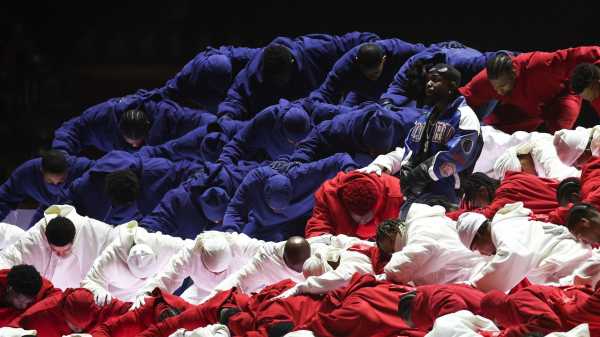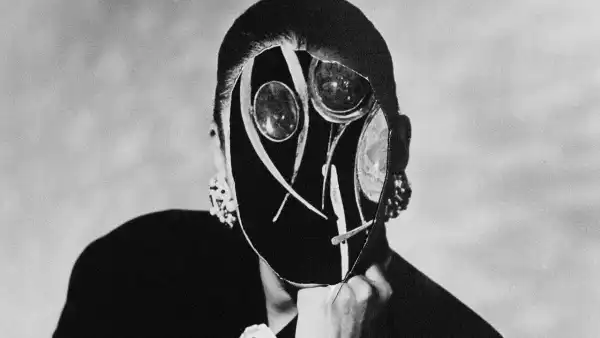
Save this storySave this storySave this storySave this story
A sense of abasement hovers over the performer of the Super Bowl halftime show. It is slight, but it is there. The musician selected must be an internationally recognized star, and yet that star also has to submit to stipulations and standards set by a conservative sports organization. (The Jay-Z of it all notwithstanding.) The production team is allotted mere minutes to erect the stage setup, and, after the spectacle is wrapped, they’ve got to disassemble it just as quickly. The gig—a live gig—is essentially done for free. It ends, the performer is spirited away, and the multi-million-dollar commercials and multi-million-dollar game resume. It’s popular music as the doula to football. The next morning, everyone makes big talk about history and legend-making; the feeling of diminution lingers.
But the performer invited to take on this onerous task nearly always agrees, because there is no platform like that one in this country—a great equalizer stage, a microcosm of all things sacred and profane. Kendrick Lamar, idealized as he is as the relative ascetic among his class of self-styled rap princes, is very much attracted to such power. What makes him unique is his relationship to it: the laurels he has won, awards and commendations that include some twenty Grammys and a Pulitzer Prize—the first to be awarded to a rapper—burden his persona. (Hence the cover of his 2022 album, “Mr. Morale & the Big Steppers,” which depicts Lamar in a crown of thorns, holding his young daughter.) His ego is healthy—how could it not be? Whether you rock with his music or not, you know that he is a genius. But the complex that keeps him rooted is one of self-persecution. And so, at the Super Bowl, Lamar choreographed his anxieties crisply and memorably, but knowingly. He gave, but he only gave so much. The restraint was clear to anyone who has seen him perform in other venues—say, the BET Awards, in 2016, when he and Beyoncé stomped in the waters of liberation, doing their Black Lives Matter anthem, “Freedom,” or at the Grammys that same year, when Lamar led a prisoner’s chain gang. In the context of his earnest, theatrical shows, I think the right word to describe Lamar’s Super Bowl performance, which struck a different tone, is existential.
Lamar is not a scold, though. The show—elaborate, a real feast for the eyes—aspired to slyness. It was funny! A viewer only half paying attention would have been happy just to see the familiar face of Samuel L. Jackson materialize on her screen, giving a ghastly politician’s smile. Dressed in a Stars-and-Stripes suit designed by Bode—a premier remixer of the Wasp and bohemian traditions—Jackson cocked his head and said, “Salutations, it’s your uncle . . . Sam.” The pause in speech was thick, conjuring Uncle Tom and his fellow house negroes (a type once played by Jackson himself in “Django Unchained”), the wretched creatures riding the dangerous slip between entertainment and minstrelsy. Uncle Sam promised a clean show. Would Lamar behave? The artist emerged crouched on the hood of a muscle car, moody and looking downward. The Buick GNX is the fetish object on the cover of “GNX,” the surprise album that Lamar dropped this past November. He named the album after this rare car to invoke a kind of person whom Lamar believes to be scarce: the Black man who abides by a code.
The car door opened, and a comical number of dancers streamed out—another reference to clowning. Every dancer (and there were dozens, or even hundreds) was Black. They wore red, white, and blue, and the choreography diffused them around their star, who slid and bopped in boot-cut Celine jeans, a letterman jacket, and a backward N.F.L. cap.
A certain pique used to emanate from Lamar when he was onstage. I’ve seen him perform three times. The first was in a degrading context: Brown University’s annual Spring Weekend, in 2013. He was distant from the audience. He hoarded his soul as drunk college students rapped along to every word of “Swimming Pools,” a melancholic song about alcoholism and the depression that takes over our uncles and our fathers, from the album “Good Kid, m.A.A.d City.” How much older Lamar is now. On Sunday, he ruled the stage and hit his marks with an oily ease, more like a crooner than a rapper. He looked sexy, too, smiling and two-stepping, even as he delivered the G-funk-infused hostility of “Squabble Up,” his first big set piece. His smoothness contrasted interestingly with the main stage, designed to evoke both the nighttime streets of Compton, California, the place that made him, and the barrenness of a prison yard. The dancers were sometimes in a phalanx, jerking militaristically, and sometimes they were utterly free.
There were four stages altogether. Lighting made them look, in the overhead drone shots, like the buttons of a video-game controller. Uncle Sam made a reference to “playing a game.” There are songs in Lamar’s catalogue—“Alright,” the aforementioned “Swimming Pools,” hell, even his verse on Taylor Swift’s “Bad Blood”—that seem like obvious arena fodder, that play the game well. But Lamar stuck mostly to recent tracks (save for songs such as “Humble” and “DNA”) rewarding newcomers to his work. “GNX” is a paean to California music—G-funk, hyphy, and flamenco make the regionalism undeniable to the ear—a love letter completely overwhelmed, in music conversations, by its status as a death knell to the cult of Drake. His semi-acknowledged dislike of the Canadian rapper, who ruled the twenty-tens, erupted in exquisite fashion; Lamar’s denigrations not only of the man but of what the man represents catapulted him to the stratosphere. The dis track “Not Like Us,” which posits Drake as a poser, a culture vulture, and much worse, is ubiquitous; the slamming notes come in, and in almost any room in the world, people stand upright. “Certified Lover Boy? Certified pedophile,” a line from the song, is arguably one of the more famous lyrics of the past decade.
These days, Lamar seems captive to his own dominance. I think he needs some antagonism, some sense of misalignment with the mores of so-called popular culture to completely flourish. But 2024 made him a king and he is working with it. Lamar had it both ways last night, using the Drake candy to smuggle in his thesis on the perils of Black entertainment. Serena Williams, whom Drake allegedly dated and then disparaged in a song, appeared for a second, crip-walking—the same dance she was admonished for doing after a win in tennis, many years back. Two wrongs, one personal, the other racial, righted at once! Drake has initiated a lawsuit against UMG, Lamar’s record label, for defamation and harassment. (The label has called the suit “illogical” and “frivolous.”) “I want to perform they favorite song,” Lamar teased during the halftime show, mock-confessing with his dancers, “but you know they love to sue.” The camera then swept to the singer-songwriter SZA, a work wife of sorts for Lamar, and a muse of Drake’s, who appeared prone on one of the stages, singing “All the Stars,” a crowd-pleaser from the “Black Panther” album Lamar curated.
If a message is blaring, is it still subliminal? Setting the tone of his set early on, Lamar invoked the poet and singer Gil Scott-Heron: “The revolution’s about to be televised,” he said. “You picked the right time but the wrong guy.” Later, the dancers assembled into a flag, their brightly colored backs acting as paint. Lamar walked through them, splitting the flag, and the people, who were now Black bodies, splayed on the ground like chalk outlines. This was either the nadir or zenith of the act, I think, not the eventual performance of “Not Like Us,” which came toward the end, with Lamar grinning into the camera as he needled Drake. This wasn’t a display of Black trauma for the white gaze—Lamar’s disassembled flag was a visual tailored toward the contemporary Black gaze. An aspect of déjà vu weighs down these expressions of Black resistance, trapped in the box of the camera frame. Consider the performance a kind of choose-your-own-adventure. One segment of the audience is appalled, another is amused, another is politically invigorated. We should consider feeling a bit numb. At one point, one of Lamar’s dancers produced a Sudan-Palestine flag. The dancer was chased by security and has reportedly been banned from N.F.L. stadiums and events for life. Throughout Lamar’s thirteen-minute performance, the camera would pivot to Uncle Sam, in interstitials, who gave his reprisals and his approvals: “Too loud, too reckless, too ghetto.” Of SZA’s softness, he said, “That’s what America wants! Nice and calm.” To Lamar’s conjuring of Compton, “Oh, I see you brought your homeboys with you, the old culture cheat code. Scorekeeper, deduct one life.” The meta-performance, the absorption of critique into the work—this is the tenor of much Black popular art as it drifts further and further from the plaintive and plain speaking of what was the Black Lives Matter commercial era, into a palpable ambivalence.
Was this the political subversion America needed? A protest performance force-fed to no one as influential as the reinstalled aspiring dictator, Donald Trump, who attended the Super Bowl to root for his beloved Kansas City Chiefs? That team, consistently dominant, lost handily to the Philadelphia Eagles. Lamar being there extends the good mood in popular culture this month. At the Grammys, “Not Like Us” dominated as well, and young female performers took most of the spoils. A sad joke has emerged: these monocultural “wins” give glimpses into the Harris Administration that was not. No one is too serious. A fever dream of sanguinity is emerging. Find hope where you can, right? Next year, we’ll do it again. And the year after, too. ♦
Sourse: newyorker.com







